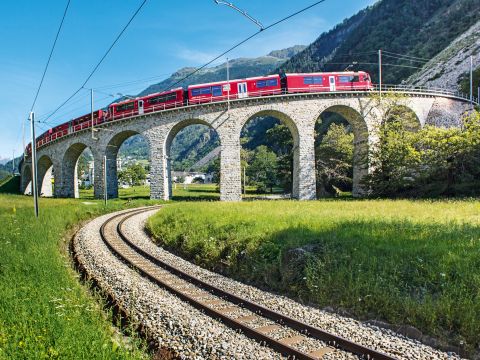A masterpiece of railway engineering: UNESCO World Heritage RhB

The RhB and the Great Wall of China look each other in the eye: In 2008, the railway line between Thusis and Tirano received recognition as a UNESCO World Heritage site. It is a distinction that honours us, but also one that supposes obligations.
Primeval landscapes, breathtaking views and masterpieces of architecture help turn a trip through the Albula and Bernina landscapes aboard the RhB into an unforgettable experience. The year 2008 saw the 122 km-long, almost century-old section between Thusis and Tirano receive the accolade “RhB in the Albula and Bernina Landscapes”, thereby confirming its inclusion in UNESCO’s World Heritage list. This makes it part of a select catalogue that includes such illustrious cultural monuments as the Taj Mahal, the Great Wall of China and the Acropolis; all of which are likewise well-known UNESCO World Heritage sites.
The significance of this accolade for the RhB
The awarding of UNESCO World Heritage status is without doubt a major honour, but it also supposes important obligations. With its inclusion in the UNESCO World Heritage list, the RhB promises – before the entire community of nations – to protect world heritage and keep it intact and authentic for the benefit of future generations. New projects, rebuilding and repair work involving railway infrastructure must all conform to UNESCO’s protection guidelines. The RhB World Heritage Association has been formed to help ensure that regional development continues to abide by the values and objectives of UNESCO. Consisting of representatives of the RhB, the Swiss federal authorities, the cantonal government and the municipalities that lie within its boundaries, its mission is to manage the conservation and sustainable use of the world heritage for which it is responsible.
Rebuilding of the Albula Tunnel in the UNESCO World Heritage zone
The Albula Tunnel is considered to be the heart of the UNESCO World Heritage line. This UNESCO World Heritage status is therefore to be taken into account during the construction of Albula Tunnel II and the renovation of Albula Tunnel I to convert it into a safety tunnel. The RhB has cooperated closely, throughout the planning of the new tunnel, with the cantonal and Swiss federal authorities in charge of listed buildings. All changes affecting its appearance and the layout of the site, along with the surrounding railway infrastructure, have been discussed in detail and the results laid down in the form of a master plan designed to act as a guideline when dealing with the substance of the historic structure and any new buildings that might be required.
This master plan includes, along with other items, the following measures designed to conserve the overall appearance of the landscapes and historic buildings involved:
-
Listed structures located in tight spaces are to be moved or, alternatively, dismantled and rebuilt after the completion of construction work
-
The entrances of the new tunnel, including the approaches, are to be designed in harmony with the listed-building status of the original
-
Landscape features such as embankments, cuttings and paths are to be preserved
-
The various temporary modifications required for the purposes of construction work are to be reversed once work is complete

